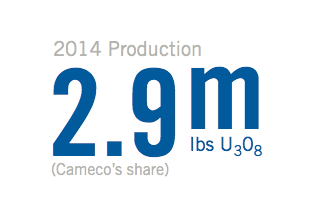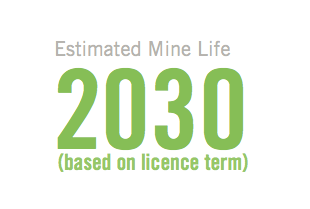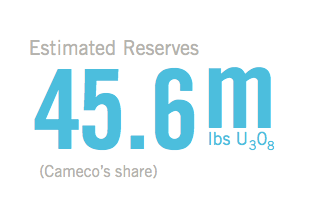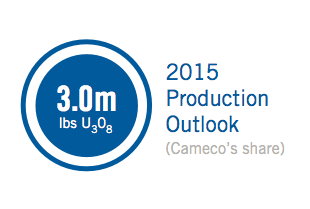Inkai
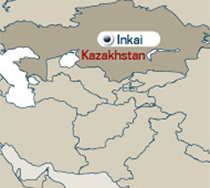
Inkai is a very significant uranium deposit, located in Kazakhstan. There are two production areas (blocks 1 and 2) and an exploration area (block 3). The operator is joint venture Inkai limited liability partnership, which we jointly own (60%) with Kazatomprom (40%).
Inkai is one of our three material uranium properties.
| Location | South Kazakhstan |
| Ownership | 60% |
| End product | Uranium concentrates |
| Certifications | BSI OHSAS 18001 ISO 14001 certified |
| Estimated reserves (our share) | 45.6 million pounds (proven and probable), average grade U3O8: 0.07% |
| Estimated resources (our share) |
30.0 million pounds (indicated), average grade U3O8: 0.08% 145.9 million pounds (inferred), average grade U3O8: 0.05% |
| Mining methods | In situ recovery (ISR) |
| Licensed capacity (wellfields) | 5.2 million pounds per year, (our share 3.0 million pounds per year) |
| Licence term | Block 1: 2014, Block 2: 2030 |
| Total production: 2008 to 2014 (our share) | 14.9 million pounds |
| 2014 production (our share) | 2.9 million pounds (5.1 million pounds on 100% basis) |
| 2015 production outlook (our share) | 3.0 million pounds (5.2 million pounds on 100% basis) |
| Estimated decommissioning cost (100% basis) | $9 million (US) |
2014 update
Production
Total production from Inkai was 5.1 million pounds; our share was 2.9 million pounds. Production was 3% lower than both our forecast for the year and our production in 2013. Inkai experienced delays in bringing on new wellfields as a result of abnormally heavy snowfall and a rapid spring melt in 2014.
Project funding
We have a loan agreement with Inkai whereby we funded Inkai’s project development costs. As of December 31, 2014, there was $55 million (US) of principal outstanding on the loan. In 2014, Inkai paid $1.8 million (US) in interest on the loan and repaid $48 million (US) of principal.
Under the loan agreement, Inkai first uses cash available every year to pay accrued interest, then uses 80% of the remaining cash available for distribution to repay principal outstanding on the loan. The remaining 20% is distributed as dividends to the owners.
We are also currently advancing funds for Inkai’s work on block 3. As of December 31, 2014, the block 3 loan principal amounted to $136 million (US).
Production expansion
In 2012, we entered into a binding memorandum of agreement (2012 MOA) with our joint venture partner, Kazatomprom, setting out a framework to:
- increase Inkai’s annual production from blocks 1 and 2 to 10.4 million pounds (our share 5.2 million pounds) and sustain it at that level
- extend the term of Inkai’s resource use contract through 2045
Kazatomprom is pursuing a strategic objective to develop uranium processing capacity in Kazakhstan to complement its leading uranium mining operations. Their primary focus is now on uranium refining, which is an intermediate step in the uranium conversion process. A Nuclear Co-operation Agreement between Canada and Kazakhstan is in place, providing the international framework necessary for applying to the two governments for the required licences and permits. We expect to pursue further expansion of production at Inkai at a pace measured to market opportunities. Discussions continue with Kazatomprom.
Block 3 exploration
In 2014, Inkai continued construction of the test leach facility and test wellfields, and advanced work on a preliminary appraisal of the mineral potential according to Kazakhstan standards.
Planning for the future
Production
We expect total production from blocks 1 and 2 to be 5.2 million pounds in 2015; our share is 3.0 million pounds. We expect to maintain production at this level until the potential expansion under the 2012 MOA proceeds.
Block 3 exploration
In 2015, Inkai expects to complete construction of the test leach facility and continue working on a final appraisal of the mineral potential according to Kazakhstan standards.
Managing our risks
Supply of sulphuric acid
There were minor weather-related interruptions to sulphuric acid supply during 2014. Given the importance of sulphuric acid to Inkai’s mining operations and shortages in previous years, we closely monitor its availability. Our production may be less than forecast if there is a shortage.
Block 3 licence extension
Inkai is working to extend the term of its current exploration licence, which expires in July, 2015. Although a number of extensions of the licence term have been granted by Kazakh regulatory authorities in the past, there is no assurance that a further extension will be granted. Without such extension, there is a risk we could lose our rights to block 3, and a risk we will not be compensated for the funds we advanced to Inkai to fund block 3 activities.
Political risk
Kazakhstan declared itself independent in 1991 after the dissolution of the Soviet Union. Our Inkai investment and plans to increase production are subject to the risks associated with doing business in developing countries, which have significant potential for social, economic, political, legal and fiscal instability. Kazakh laws and regulations are complex and still developing and their application can be difficult to predict. To maintain and increase Inkai production, we need ongoing support, agreement and co-operation from our partner and the government.
The principal legislation governing subsoil exploration and mining activity in Kazakhstan is the Subsoil Use Law dated June 24, 2010, and amended on December 29, 2014 (new subsoil law). It replaces the Law on the Subsoil and Subsoil Use, dated January 27, 1996.
In general, Inkai’s licences are governed by the version of the subsoil law that was in effect when the licences were issued in April 1999, and new legislation applies to Inkai only if it does not worsen Inkai’s position. Changes to legislation related to national security, among other criteria, however, are exempt from the stabilization clause in the resource use contract. The Kazakh government interprets the national security exemption broadly.
With the new subsoil law, the government continues to weaken its stabilization guarantee. The government is broadly applying the national security exception to encompass security over strategic national resources.
The resource use contract contains significantly broader stabilization provisions than the new subsoil law, and these contract provisions currently apply to us.
To date, the new subsoil law has not had a significant impact on Inkai. We continue to assess the impact. See our annual information form for an overview of this change in law.
We also manage the risks listed here.

